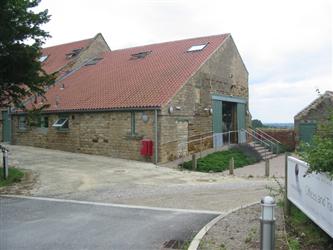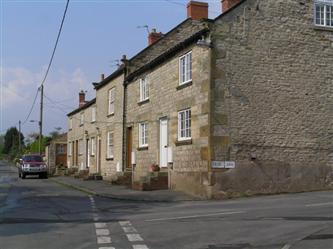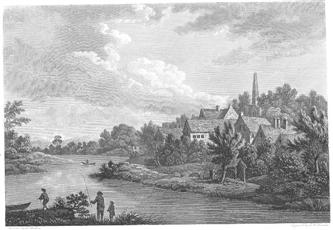|
iii.
|
|
Matthew
Bilton,[219,222,227] probably born between 1700-1710.[202,203]
{From DOBs of children}
Died 9/11/1791, North America.[206] {Whilst no
location is given, the death is listed in the North American IGI,
consistent with his transportation there in 1758, see below}
Labourer,[219] 1757.[229,230]
| |
According to a deposition of the Hon
and Rev. Henry Egerton, Rector of Setterington, East Riding, Co
Yorkshire, dated 16-19/12/1757, a "Riot lead by Matthew Bilton of
Kilburn, labourer, within the North Riding had demanded 7 guns (one for
each Township) from him at the head of a mob of 100 people firing guns
and crying "No Militia", which he refused to pay except to the
Constables." witnesses were T. Norcliffe, J. Sterne & B.
Legard.[229] John Henshaw, servant to Lady Betty Egerton, was to give
evidence.[229] According to another account, "Matthew Bilton, William
Watson, Richard Ford, Robert Cole and George Berry. Monday, May 1st,
A.D. 1758. - The above rioters were executed at the Tyburn without
Micklegate Bar, pursuant to their sentence. Bilton, Watson, and Ford
were convicted of high treason, and were not only hanged, but drawn and
quartered. In their rioting wantonness they proceeded from market-town
to market-town demanding money from the inhabitants, and using violent
threats, by which they obtained seven guineas from the servants of Mr.
Osbaldeston; also money from the Hon. and Rev. Henry Egerton. They died
remarkably penitent, confessed to their being concerned in the said
riots, and exhorted their countrymen to take warning from their
untimely fate. Cole, in addition to the crime of rioting, was convicted
for obstructing the execution of the Militia Act, They were called the
"Wensleydale rioters," and originated in consequence of the high price
of corn."[230] Whilst the above account implies Matthew was executed
for his crimes, according to the York Castle Prison records, Matthew
Bilton was convicted of "high treason for levying war against the king:
riotous and armed (Militia Act)" on 13/3/1758 but received a reprieve
8/7/1758 with his sentence commuted to transportation.[231] |
|
Married
Ann Weatherall,[202,222,227] 12/7/1730, St John the Baptist &
All Saints, Easingwold, North Riding, Co
Yorkshire, England.[203] Ann baptised 25/9/1705, St John the Baptist
& All Saints, Easingwold, North
Riding, Co Yorkshire, England,[215] died 1791 & buried
11/11/1791,
St Mary, Kilburn, North Riding, Co Yorkshire, England.[219,221] Resided
1744, Low Kilburn, North Riding, Co Yorkshire, England.[219] Resided
1791, Old Stead, Kilburn, North Riding, Co Yorkshire, England.[219]
Children:
(a)
|
|
Ann
Bilton, baptised
2/4/1731, St John the Baptist & All Saints, Easingwold, North
Riding, Co Yorkshire, England.[203] Died infancy. |
| (b) |
|
Mary
Billton, baptised 31/7/1732, St John the Baptist & All Saints,
Easingwold, North Riding, Co
Yorkshire, England.[203] Married
Edward Wells, 28/9/1755, Coxwold,
North Riding, Co Yorkshire, England.[215] |
| (c) |
|
Ann
Bilton, baptised 13/8/1733, St John the Baptist & All Saints,
Easingwold, North Riding, Co Yorkshire, England.[203] |
| (d) |
|
Margaret
Bilton, baptised 2/12/1734, St John the Baptist & All Saints,
Easingwold, North Riding, Co
Yorkshire, England.[203,227] Died 1818 & buried 22/11/1818, St
Mary, Kilburn, North Riding, Co Yorkshire, England (84yo).[219,227] Married
John Bourn/Burn, 25/3/1754-1755, St Mary, Kilburn, North Riding, Co
Yorkshire,
England.[202,219,227] John died 1809 & buried 12/3/1809, St
Mary, Kilburn,
North Riding, Co Yorkshire, England.[219,227] Witnesses were John
Britton & George Champla, with the consent of the parents.[219]
Resided 1757,1759,1762,1764,1766,1768,1772,1773,1778,1809, Common End,
North Riding, Co Yorkshire, England.[219]
Children:
(1)
|
|
Elizabeth
Burn, baptised 1/5/1755, St Mary, Kilburn, North Riding, Co Yorkshire,
England.[227] |
| (2) |
|
Benjamin
Bourn, baptised 24/2/1756-1757, St Mary, Kilburn,
North Riding, Co Yorkshire, England.[219,227] Died 1778 &
buried
28/7/1778, St Mary, Kilburn, North Riding, Co Yorkshire,
England.[219,227] |
| (3) |
|
Mary
Bourn, baptised 25/9/1759, St Mary, Kilburn, North Riding, Co
Yorkshire, England.[219,227] |
| (4) |
|
Jane
Bourn, baptised 14/2/1761-1762, St Mary, Kilburn,
North Riding, Co Yorkshire, England.[219,227] Died 1764 &
buried
18/11/1764, St Mary, Kilburn, North Riding, Co Yorkshire,
England.[219,227] |
| (5) |
|
Margaret
Burn, baptised 3/5/1764, St Mary, Kilburn, North
Riding, Co Yorkshire, England.[219,227] Married
William Ellis,
9/10/1787, St Mary, Kilburn, North Riding, Co Yorkshire, England.[227] |
| (6) |
|
Ann
Bourn, baptised 12/7/1766, St Mary, Kilburn, North
Riding, Co Yorkshire, England.[219,227] Married
William Ellis,
6/9/1792, St Mary, Kilburn, North Riding, Co Yorkshire, England.[227] |
| (7) |
|
Hannah
Bourn, baptised 9/10/1768, St Mary, Kilburn, North
Riding, Co Yorkshire, England.[219,227] Married
Thomas Claxton,
25/11/1815.[227] |
| (8) |
|
John
Burn,
baptised 13/7/1771, St Mary, Kilburn, North Riding, Co Yorkshire,
England.[227]
Died 1846 & buried 15/10/1846, St Mary, Kilburn, North Riding,
Co Yorkshire,
England.[227] Married
Mary Ibbotson, 23/5/1793, St Mary, Kilburn, North Riding,
Co Yorkshire, England.[227] |
| (9) |
|
Matthew
Burn, baptised 26/11/1772, St Mary, Kilburn, North Riding, Co
Yorkshire,
England.[219,227] Died 1773 & buried 17/12/1773, St Mary,
Kilburn, North
Riding, Co Yorkshire, England.[219,227] |
| (10) |
|
Matthew
Burn, baptised 11/7/1777, St Mary, Kilburn, North
Riding, Co Yorkshire, England.[227] Married
Sarah Clark,
23/11/1802.[227] |
| (11) |
|
Benjamin
Burn, baptised 28/7/1788, St Mary, Kilburn, North Riding, Co Yorkshire,
England.[227] |
|
| (e) |
|
Elizabeth
Bilton, baptised 7/4/1736, St John the Baptist & All Saints,
Easingwold, North Riding, Co
Yorkshire, England.[203] Died 1801 & buried 18/11/1801, St
Mary, Kilburn,
North Riding, Co Yorkshire, England.[219] Married
John Nickson/Nixon,
17/2/1756-1757, St Mary, Kilburn, North Riding, Co Yorkshire,
England.[219]
Witnesses Matthew Bilton, Joseph Wood, with consent of the
parents.[219] John a labourer.[219] John died 1790 & buried
21/6/1790, St Mary, Kilburn, North Riding, Co Yorkshire, England.[219]
Resided
1790,1801, Old Stead, Kilburn, North Riding, Co Yorkshire, England.[219] |
| (f) |
|
Dorothy
Bilton, baptised 26/5/1739, St John the Baptist & All Saints,
Easingwold, North Riding, Co Yorkshire, England.[203] |
| (g) |
|
Jane
Bilton, baptised 26/5/1739, St John the Baptist & All Saints,
Easingwold, North Riding, Co
Yorkshire, England.[203] Married
John Elwick, 8/8/1763, St Mary, Kilburn, North
Riding, Co Yorkshire, England.[202,219] Witnesses William Atkinson,
Christopher Smaels.[219] John was of Bagby, Co Yorkshire, England.[219] |
| (h) |
|
Hannah
Bilton, baptised 12/10/1744, St Mary, Kilburn, North Riding, Co
Yorkshire, England.[202,219,227] Married
Thomas Buck, 5/8/1775, St Mary, Kilburn, North Riding, Co Yorkshire,
England.[219,227] Witnesses were
William Atkinson & William Sutton.[219] Labourer, 1778.[219]
Farmer, 1778.[219] Labourer, 1779.[219] Resided 1775, Low Kilburn,
North Riding, Co Yorkshire, England.[219] Resided 1777, Old Stead,
North Riding, Co Yorkshire, England.[219] Resided 1778, Kilburn, North
Riding, Co Yorkshire, England.[219] Resided 1779,1788, Old Stead, North
Riding, Co Yorkshire, England.[219]
Children:
(1)
|
|
Thomas
Buck, baptised 30/6/1775, St Mary, Kilburn, North Riding, Co Yorkshire,
England.[219] |
| (2) |
|
Ann
Buck, baptised
28/6/1777, St Mary, Kilburn, North
Riding, Co Yorkshire, England.[219] Died 1778 & buried
29/4/1778,
St Mary, Kilburn, North Riding, Co Yorkshire, England.[219] |
| (3) |
|
William
Buck.[219] Died 1779 & buried
3/4/1779, St Mary, Kilburn, North Riding, Co Yorkshire, England.[219] |
| (4) |
|
Matthew
Buck, baptised 8/8/1778, St Mary, Kilburn, North Riding, Co Yorkshire,
England.[219] |
| (5) |
|
John
Buck, baptised 16/3/1779-1780, St Mary, Kilburn,
North Riding, Co Yorkshire, England.[219] Died 1788 & buried
24/6/1788, St Mary, Kilburn, North Riding, Co Yorkshire, England.[219] |
|
|














































































































































